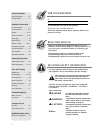
10
Installing the (INDOOR) water heater:
The water heater must be installed with a 3” diameter UL approved Category III Stainless Steel appliance
vent pipe and an appropriate adapter.
Venting
The installation of venting must comply
with national codes, local codes and the
vent manufacturer’s instructions.
The water heater must be vented to the
outdoors as described in these instructions.
DO NOT connect this water heater to a
chimney. It must be vented separately from
all other appliances.
All vent components (adapters, pipe, elbows,
terminals, etc.) should be UL 1738 Certified
Stainless Steel Venting Material
(e.g. AL29-4C).
The specified vent termination must be used.
The termination should be a 90° elbow with
screen. (Refer to pages 14 and 15 for an
example of 90° termination)
Use a vent pipe with an anti-disconnection
joint.
The use of a High Temperature Silicone
(500°F [260°C]) may be required to seal
vent connections. To prevent accidental gas
exhaust leakage, apply a 1/4” (6 mm) wide
bead approximately 1/4” (6 mm) from the
end and another bead against the joint side
of the stop bead.
Follow vent manufacturer’s installation
instructions and their recommended
clearances to combustibles.
The unit can be vented either horizontally
or vertically.
Vent pipe runs must be adequately supported
along both horizontal and vertical runs.
The maximum recommended unsupported
span should be no more than five (5) feet
(1.5 m). Support isolation hanging bands
should be used. DO NOT use wire. (See
diagram below).
Notes on pr
e-existing v
ent:
If the water heater is being installed as a
replacement for an existing water heater, a
thorough inspection of the existing venting
system must be performed prior to any
installation work. Verify that the correct
materials, vent lengths and terminal locations
as detailed in this Use and Care Manual have
been met. Carefully inspect the entire
venting system for any signs of cracks or
fractures, particularly at the joints between
elbows or other fittings and the straight runs
of vent pipe. Check the system for signs of
sagging or other stresses in the joints as a
result of misalignment of any components in
the system. If any of these conditions are
found, they must be corrected in accordance
with the venting instructions in this manual
before completing the installation and
putting the water heater into service.
Additional installatio information for The
Commonwealth of Massachusetts is located
on the back page of this manual.
DANGER: Failure to
install the appliance vent
adapter and properly vent
the water heater to the
outdoors as outlined in the
Venting section of this
manual will result in unsafe
operation of the water
heater, causing death,
serious injury, explosion,
or fire. To avoid the risk
of fire, explosion, or
asphyxiation from carbon
monoxide, NEVER operate
the water heater unless it is
properly vented and has
adequate air supply for
proper operation as
outlined in the Venting
section of this manual.
WARNING: Use 3”
UL approved Category III
Stainless Steel vent
material only. No other
vent material is permitted.
WARNING: Refer to
page 8 for clearances to
combustible material.
NO! YES!
Venting Lengths
MAXIMUM VENT LENGTH: The
system will not operate if there is excessive
restriction (pressure drop) in the venting
system. A maximum 34’ 6”
(10.5 m)
of vent
pipe may be used provided there is only one
90° elbow in the system. If additional elbows
are required: two elbows can be used with 33’
(10.0 m)
, three elbows can be used with
31’
6” (9.5 m)
or four elbows can be used with
30
’
(9.2 m) of vent pipe.
A 90° elbow is equivalent to 1’6” (45cm) to
straight pipe. A 45° elbow is equivalent to 9”
(22 cm) of straight pipe.
The termination elbow does not count as an
elbow when determining total vent lengths.
The vent can be installed with a slight
downward slope of 1/4” per foot of
horizontal run toward the vent terminal (see
diagram below). This ensures that any
condensate formed during operation of the
unit is evacuated from the appliance.
A 1/4” per foot upward slope is acceptable
when it is not possible to vent with a
downward slope; however, a UL approved
Category III Stainless Steel condensate trap
MUST be installed at the beginning of the
horizontal run. (See page 14 “Example B:
Typical Horizontal Termination w/ 1/4” per
foot UPWARD Slope” or page 15, “Standard
Vertical Vent Termination” for examples).
MINIMUM VENT LENGTH: The venting
may be as short as 12” (30 cm), provided
one vent termination is installed to the
outdoors through a sidewall, one 90° elbow
is included in the installation and the wall
thimble is installed.
Notice: Make sure that the seam of the vent
pipe in horizontal runs is toward the top of
the installation (see diagram to the far left).
Min. 3"
(8 cm)
Max. 2 feet
(61 cm)
1/4" per foot
downward slope
Vent Seam
Number of
90° elbows
(bends)
Maximum
Length of
Straight Pipe
1
2
3
4
34’ 6”
(10.5 m)
33’
(10.0 m)
31’ 6”
(9.5 m)
30’ 0”
(9.2 m)


















